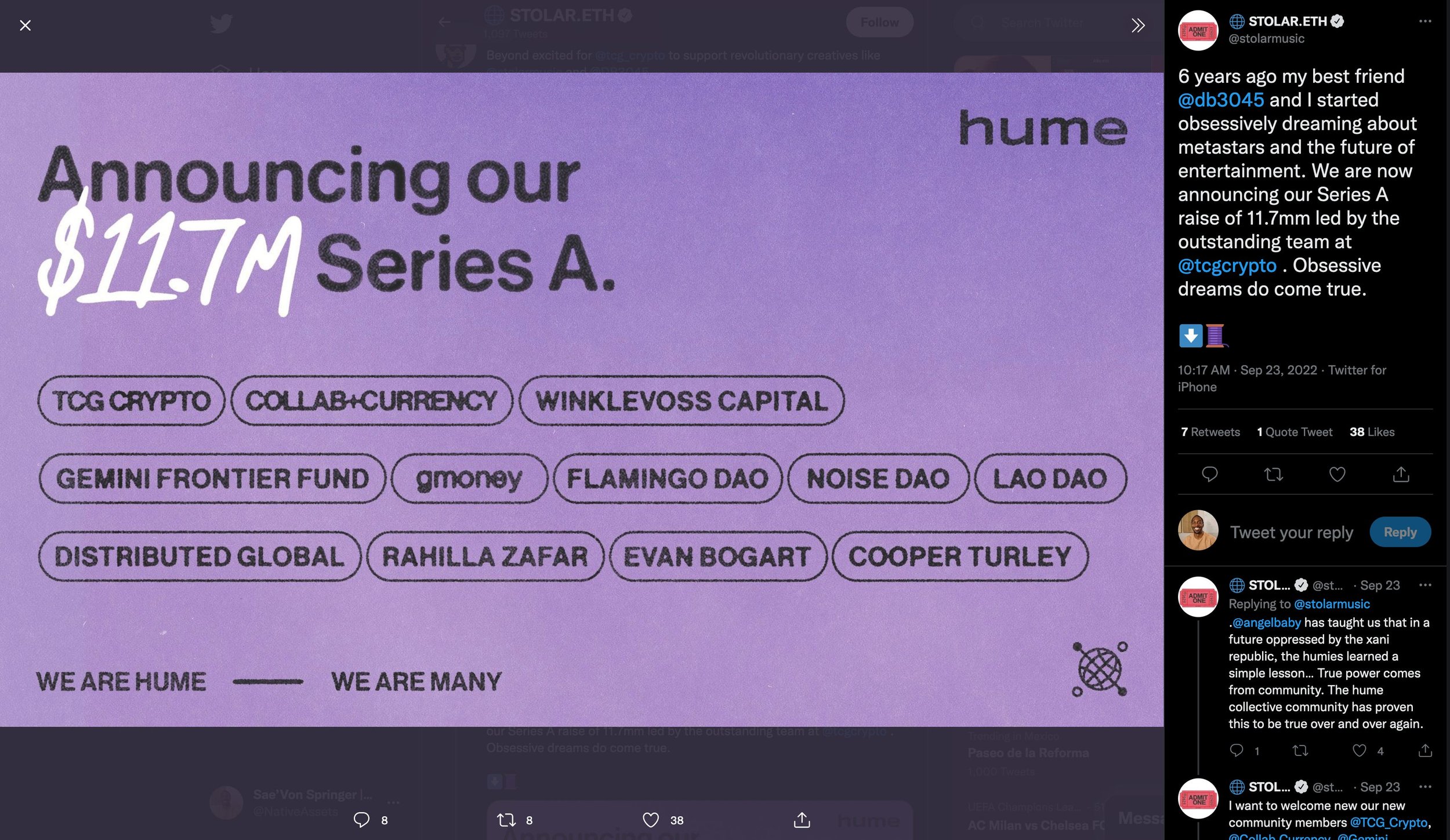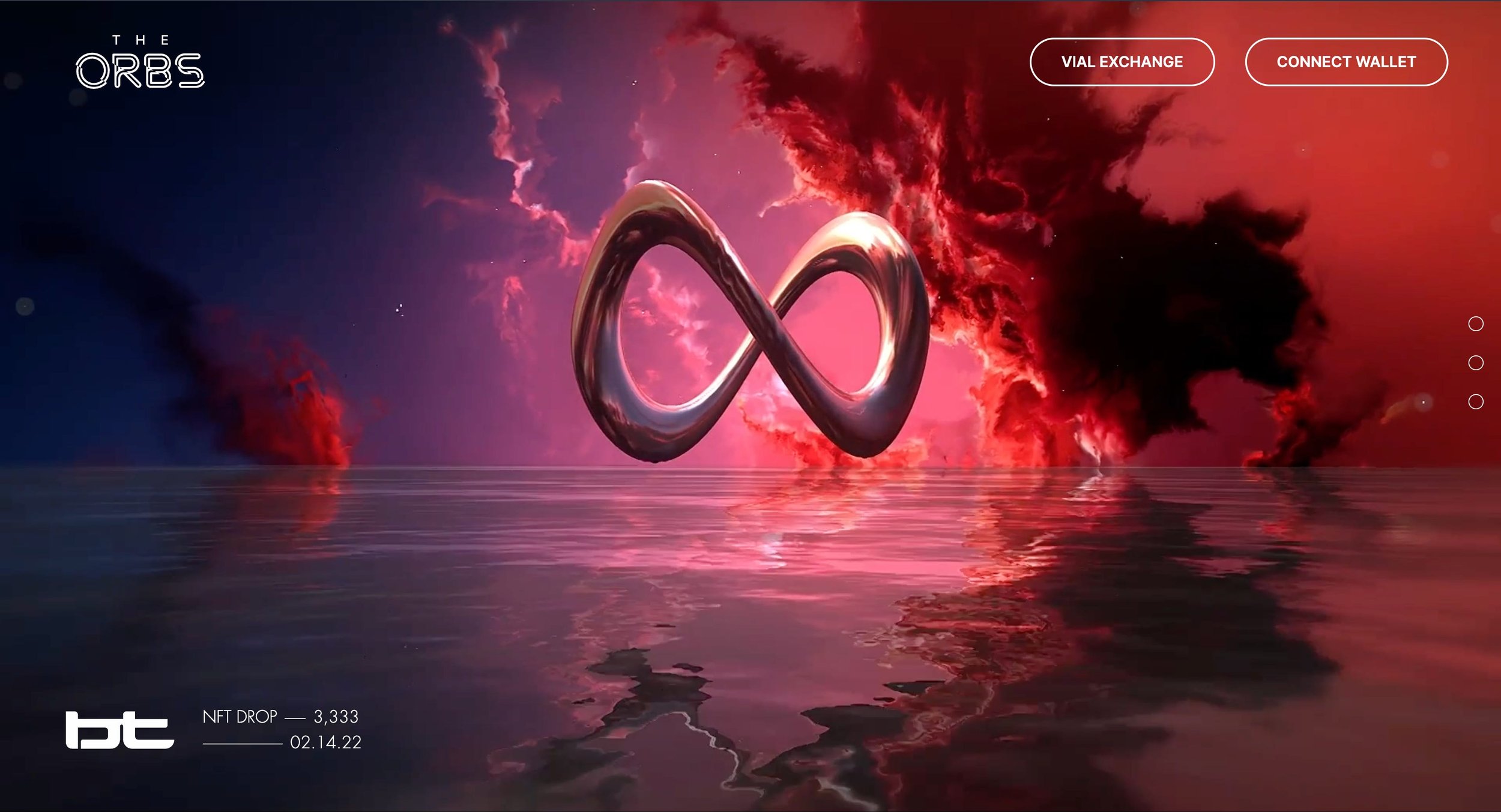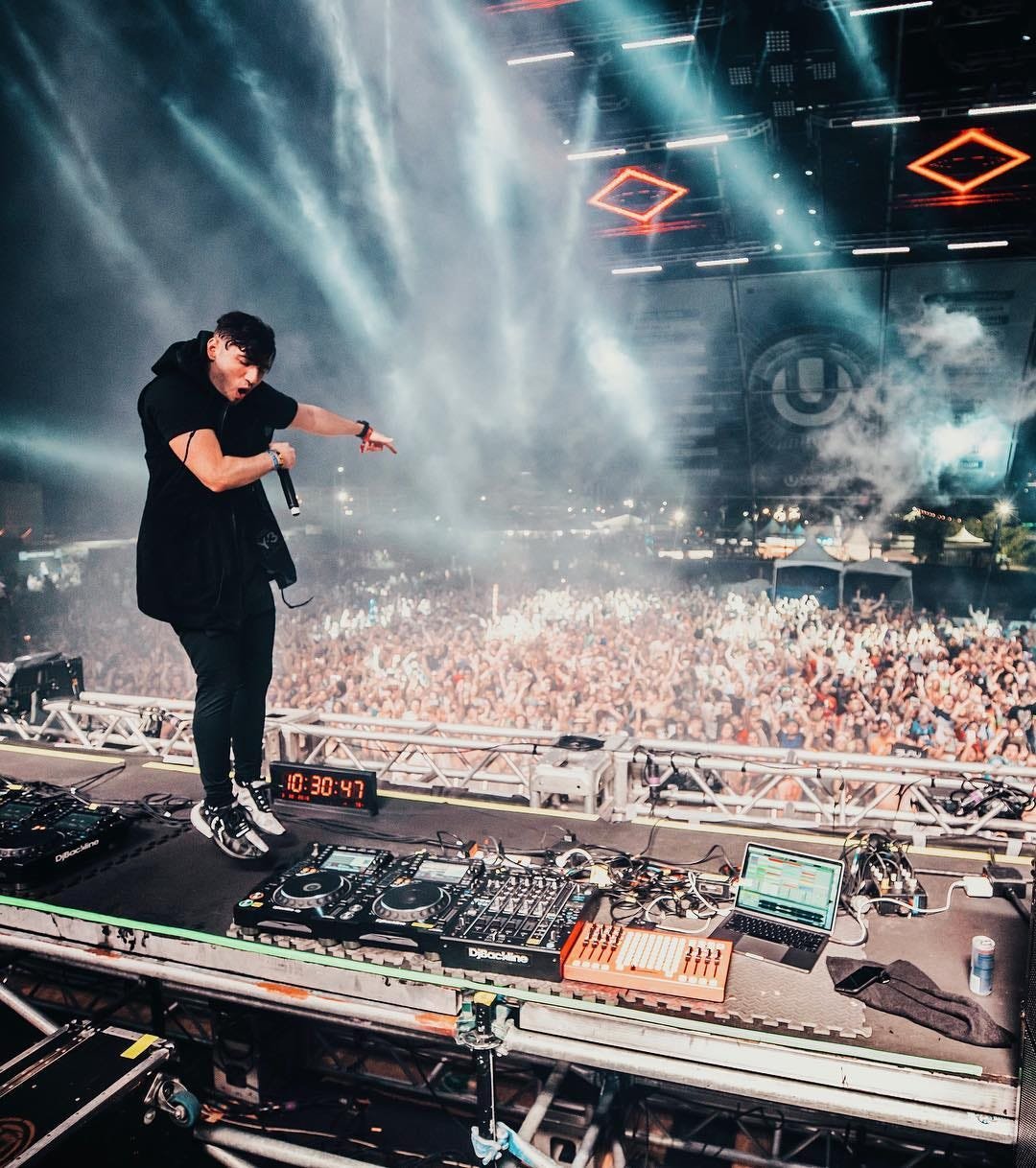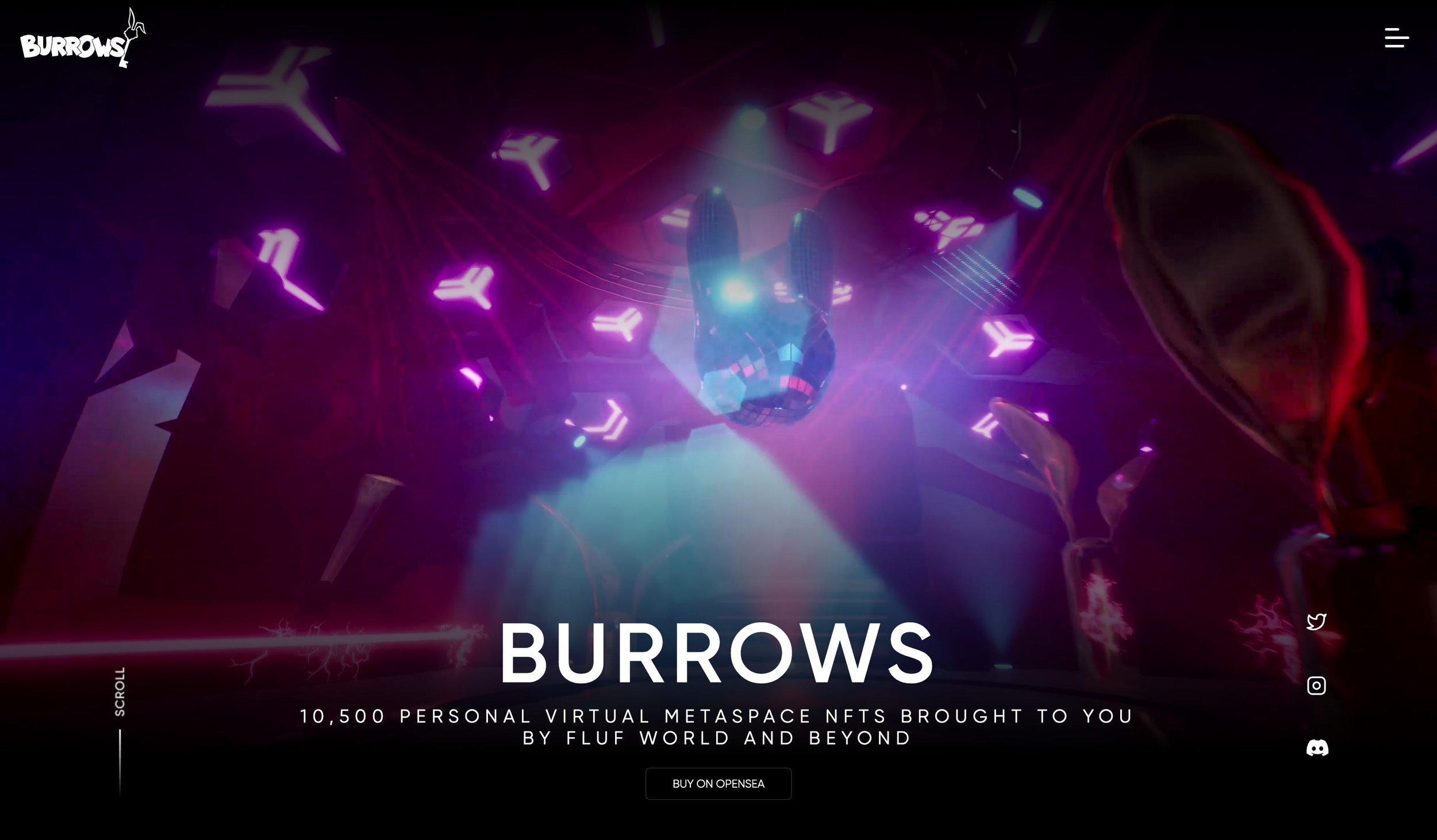Music NFTs: A Billion Dollar Wav Worth Riding? 🌊
From artists & Metastars to labels & distribution, here's everything you need to know about music in Web3.
Sae’Von Springer - Founder & Managing Partner, Native Assets
Did you know that a virtual rabbit performed a set at SXSW & Art Basel?
Did you know that Warner Music just launched a Web3 music label?
Did you know that Muse topped the UK charts with their NFT album?
If any of this is news to you or you’re fascinated by why any of this matters - keep watching, cause we’re gonna dive deep into all things Music NFTs.
This article was originally published on the Native Assets Substack on October 17, 2022
Music NFTs Are Exploding
Whether it's major labels like UMG backing a band of Apes, Opensea debuting their launch platform with a string of music collections or indie artists selling tokenized albums & making 1000X as much as they would've via Spotify - it’s undeniable that music NFTs have been making a splash lately.
Hume Raises Nearly $12M For Their Metastar Label
Given the million dollar raises & big names backing the bubbling niche of NFTs - it makes sense to step back and assess the landscape. Are we at the front end of a Cambrian explosion in music NFTs or is everyone just drinking the kool aid, grasping for hope in this current market environment?
Spoiler alert - I’m convinced this is much more than a fad & that in reality, we’re witnessing the foundations being laid for major disruption to the status quo of music - creatively, culturally & commercially.
Why Should You Care About Music NFTs?
Even if I’m right - why does it matter? Why should you care at all about Music NFTs?
If you’re an artist or a fan of music, you already know that the traditional music system is broken. Skewed incentive models have led to formulaic songs optimized for replay-ability & streams, resulting in low morale for many artists trying to make a living from their passion, fighting for relevancy & visibility amongst the mighty Spotify algorithms & playlist curators.
In short - artists want to reprice music, express their full creativity & retain ownership.
Music NFTs provide a golden opportunity for all that - and then some.
WHAT ARE MUSIC NFTs?
THE HISTORY OF MUSIC NFTS
Music NFTs have been around for years, but when considering innovative projects that are still going strong, I think of collections like WVRP Sounds, the first generative audio/visual music NFT that also works as a PFP. Orbs by BT also comes to mind, the first NFT utilizing dynamically synthesized & sequenced music. As far as artists, I think of folks like LaTasha & Verité. I think of collectives like SongCamp & HUME.
The ORBS by BT Combines 3D Visuals with Procedurally Synthesized Audio
In its simplest form, music NFTs are tokenized songs minted on-chain, but in practice this can take many other forms - from music videos to full on projects, collections & even memberships. The through-line of it all being the focus around music, a musical artist, or a sonic experience that requires or involves NFTs.
Today’s goal is to shine a light on the experiments playing out in this corner of the space by providing a comprehensive, albeit succinct look at a few of the artists, projects & collections at the forefront of this niche. We’ll explore the value prop & challenges of the segment & we’ll touch on some of the key platforms & protocols powering it all. If you want a dedicated video focused on any of the projects or platforms mentioned, just let me know in the comments below or holler at me on Twitter.
Let’s get into it!
CRYPTO CULTURED: A WAV OF WEB3 ARTISTS
I know I opened this whole thing up by mentioning virtual rabbits performing at major festivals, and we will get there soon, I promise, but first let's look at artists who’ve decided to focus their attention on Web3 instead of chasing playlist placements & lopsided 360 deals.
To understand what's happening here, we need to talk about 2 key concepts
The “1,000 True Fans Theory”
Micro Economies
1,000 True Fans
The 1K fans theory is a well established framework for taking music, art or any other passion & turning it into a financially viable career. If you’ve got 1K people willing to spend an average of $10/month to support you through shows, buying your songs or your merch- that’s $10K/month - a very healthy revenue stream for an artist.
Micro Economies
But what if you didn’t need 1K fans - but just 100? This is now possible thanks to Micro Economies, a model where creators place an emphasis on exclusive access, high touch interactions & incentives that drive value back to the community via tokens, perks or other potentially valuable assets. There’s a lot of nuances here & likely warrants its own video, but I suggest you read this article by Austin Horowitz for a stellar summary.
Web3 Native Breakouts
A few breakout artists have put this theory to the test & proven the model successful - culturally & commercially.
From singles & albums to music videos, LaTasha has continuously minted out her collections & is one of the most prominent artists in all of Web3 across all genres. She’s not just focused on music though, heading up Community at Zora & founding their hit festival Zoratopia.
Note that the most successful Web3 artists all share something in common: an obsession with nurturing their communities & adding value to the broader ecosystem. Daniel Allen, Verité, J’Von, & Spottie Wifi are all staples in the Web3 music scene for this very reason. Yes, they make art that resonates with fans, but they all prioritize their community.
Given their strong collector base & growing network effects, most of the top artists release their music NFTs on Zora, Sound.xyz or Catalog. For music videos, Glass.xyz seems to be the go to platform.
MAINSTREAM ARTIST ENTERING WEB3 MUSIC
Music NFTs aren’t just for indie artists though.
Low Fi legend OMGKirby has launched several NFT projects, including his genesis collection which helped pioneer the formula for Music PFPs - creating a looping scene with the various elements representing different stems of the song. Holders of the OMGKirby Genesis collection also have access to the OMGKirby DAO - a tight knit community centered around Kirby’s releases.
3LAU, one of the world's biggest electronic artists was highly active in the space throughout 2020 & in 2021 he released his own platform Royal, designed to let fans buy a piece of the royalties generated from their favorite artists.
Following a major change to the UK’s Official Charts Company, Muse released their 9th studio album as an NFT through the Serenade platform, becoming the first NFT album release eligible for UK & Australian charts.
We can’t forget to mention Snoop Dogg, who’s gone hard in the space, dropping Back On Death Row in collaboration with Gala Music, releasing CC0 tracks on Sound.xyz, co-creating the premium “Studio Snoop Dogg” Burrow for Fluf World’s genesis land collection. He’s even gone as far as removing the entire Death Row catalog from streaming services - a move that many speculate precedes a greater Web3 music strategy from the label exec.
"Studio Snoop Dogg" Is The Top Tier Burrow from Fluf World
WEB3 LABELS & DISTRIBUTION
Distribution
The thought of Snoop re-releasing his label’s entire collection of music as NFTs may seem extreme or impractical, but the tools are already in place to make this a reality. Whether its breakout web3 artists, global superstars or rising Metastars, new distribution platforms and labels are emerging to cater to this growing segment of NFT musicians.
From a distribution standpoint, Sound.xyz & Catalog are two of the more dominant players you should know about. The former focuses on the relationship between artists and their supporters, emphasizing fans' ability to “prove they were first” in discovering a new artist or song. Catalog on the other hand, is more focused on being a “digital record shop” intended to make the music the star of the show, currently only supporting 1 of 1 mints & limiting artwork to static images to minimize the risk of visuals distracting from the music itself. Between the two platforms, artists have collectively earned more than $6M to date from the release of their music as NFTs.
Web3 Music Labels
Labels are a particularly interesting segment of Music NFTs. In the traditional music business, labels used to hold immense power due to their role as gatekeepers for distribution. Once digital hit the scene, they lost that advantage. Now, their main value adds come in the form of financing, placements, sync licensing, touring infrastructure, & collaborations with other artists on the label’s roster of talent.
As game changing as all that can be, most artists don’t need that whole suite, but would still benefit from having a team helping nurture their career. Realizing things could be done differently, Troy Carter & Suzy Ryoo launched an NFT membership pass for their platform Venice Music, an all-in-one hub for artists to receive distribution, educational workshops, networking events, even providing the chance for sync placements for higher tier members.
Venice Music Founders Troy Carter & Suzy Ryoo In Forbes
Well, what if instead of corporate executives holding all the influence at labels, a community of fans had a voice at the table? Enter HUME, a community governed record label focused on building out Metastars like Angel Baby. To be clear, there’s still a centralized team guiding things in the background - chiefly the two founders David Beiner & Jay Stolar, who’ve recently raised over $11M to continue building out HUME & its metastar roster. Buying a HUME Collective Genesis NFT allows you to vote on key decisions for the label’s Artists & is the only way to access The Spot, Hume’s digital studio & collector’s lounge.
Hume Founders David Beiner + Jay Stolar with Metastar Angelbaby
Frankly, this was odd to me when I first came across it, but my conversation with Shep Ogden about Virtual Humans put all of this in context, helping me see a clear path towards a future that leans heavily on virtual influencers as notable musical artists. For instance, Angelbaby has already performed at Art Basel, SXSW & alongside T-Pain at Fluff Haus LA. If that’s not wild enough, the songs they’ve released so far have been some of the best performing tracks ever featured on Audius, a Web3 streaming platform & have even featured production from multi-platinum producers like Gino.eth, FKA GinoTheGhost.
Speaking of Gino, he’s got his own NFT project Blocktones that appears to be connected to HUME & the wider Fluf World lore, the parent collection of avatars Angelbaby originates from. which is using the Party Bear collection to establish a strong foothold in the music vertical of the greater Futureverse ecosystem. Not many details are available yet, but so far they’ve built a narrative rich world that imagines a future where all music on the charts is created by AI. Gino & his team even went so far as to tie the story back into the actual mint mechanics, specifically a process where the AI “corrupted” all the unminted Blocktones by hacking into resistance’s archives - small touches that go a long way to creating an immersive lore, but also serves a functional purpose.
Aside from Angelbaby, we’ve seen Bored Apes leveraged to create metastars like Timbaland’s Congo & Kingship, a UMG backed band founded by Celine Joshua & Jimmy McNelis. Though the collection has only been out for a few months, the band has already debuted a collab with M&Ms & appears to have production from James Fauntleroy, Hit Boy & others.
One last metastar I’ll mention is Rhoki. The project is not nearly as well known, but Cooper Turley (CoopahTroopa) mentioned it in one of his newsletter & they certainly appear to be creating something captivating.
Long story short: If you’re bullish on the metaverse & the creator economy - don’t fade this metastar trend. It’s only getting started.
Challenges With Music NFTs
Now that we’ve surveyed the Music NFT landscape, let’s talk a bit about some of the hurdles & challenges facing the niche.
Fractured Ecosystem
As of this moment, there's no universally agreed standard for publishing music directly on chain in a way that makes it both monetizable AND easily discoverable by other protocols, fans & collectors. Brandon Tory & his team at Formless are doing cool things here with their “Share” protocol, an engine for Web3 applications & digital content streaming services that also enables pay-per-stream access with instant royalty payouts.
Decent just released their protocol for no-code minting via Creator HQ & OohLaLa is an aggregation protocol with some solid traction. Regardless, its far too early to dub anything in the space as the Spotify or Distrokid of Web3. There are leaders, but there are plenty of teams building in parallel hungry to become the go-to platform.
OnCreator HQ Helps To Streamline The Music Minting Process
Instant Consumption
Regardless of any underlying utility or “experiences'', PFPs are designed to be taken at face value & have benefited immensely from their digestible nature. At this point its common to see people using PFPs to represent their online identity & brands across any platform supporting Profile Pictures. This has all created a recipe for visibility & exposure, both of which can do wonders for the volume & revenue of a collection.
Using a music NFT as your online identity in the same way as PFP collection is difficult. Consequently, music NFTs lack such a rapid & reflexive feedback loop. Yes, some collections & artists are making cool art to go along with the music, but its music at the end of the day & music can only be experienced over time. This deliberate pace clashes with the cadence of Twitter & of full time NFT flippers, a cohort that’s instrumental in the financial success of projects as they are typically high volume traders jumping in & out of collections on relatively low time frames.
Effort Required
If you have the right software tools, its pretty straightforward to kick out 10K pfps - just look at Fiverr. The technical barrier is low and there's a ton of best practices for the PFP genre. Hence, there's a ton of garbage out there.
Music NFTs are harder to pull off. As we mentioned, most aren’t PFP collections, so that’s not on the table. Even more, there are different rules to music than to visual art. You can combine some traits that clash visually but it could still work. But with all the keys, chords, melodies, harmonies & patterns involved with music, certain combinations just don’t work. If you do have the requisite music theory chops to give it a go, they are far fewer tools designed to create generative tracks.
Macro Conditions
The macro economic environment is bleak. No 2 ways about it. Considering how much collections like BAYC, Doodles, & Punks have fallen, you can bet that liquidity has dried up. Since Music NFTs are a niche within the broader NFT market which is a niche within the broader crypto market - there aren’t many people paying attention. But what may be lacking in quantity, is surely compensated by who is paying attention.
Incumbents
The traditional music business is dying. Money is still being made, but things are looking terminal. Artists know it. Execs know it. Fans & collectors are starting to notice it too. Naturally, big music isn’t going down without a fight. Many labels have doubled down on their old formulas, but certain players are realizing the need to innovate. In the past few months alone we’ve seen Warner Records launch Probably A Label, UMG partner with folks like Limewire & numerous artists & estates issue collectibles through marketplaces like OneOf. These forays into the space are promising, but the music business is not going to step aside just to watch artists make 4-5X as much money in Web3 - with none of it going back to the label.
The Bull Case For Music NFTs
Despite the challenges facing music NFTs, I’m incredibly optimistic. In my opinion, any informed & educated artist who has the ability to play in this arena - should. Here’s a quick list of reasons why.
For starters, music nfts are a new medium with new economics. According to FreeYourMusic, one million Spotify streams pays out close to $5K. Well, data from Delphi Digital calculated the average sell price of songs minted on Catalog to be about 1 ETH, which is ~$1300 at the time of recording. All this to say, you could either try to get 1M streams on Spotify, or sell 4 NFTs. Which seems more likely?
Delphi Digital Shows The Numbers Behind Catalog Drops
For context, Bloomberg reported that Iman Europe, an independent artist with just shy of 30K monthly listeners made over $60K (22.2 ETH at the time) from selling 5 singles & a music video NFT. (Sources: nftNow, FreeYourMusic, Delphi Digital) What kind of numbers would Beyonce, Kendrick or Harry Styles pull in from NFTs?
If the economics weren’t already compelling, consider the following.
Its a New Creative Canvas
Its Highly Collaborative
It Fosters Engaged Communities
Fresh Audience
Brand Facelift
Compelling Risk to Reward
Most Innovative Field In Tech, With The Lowest Barrier To Enter & The Most Cultural Appeal & Interest
How To Get Involved
So, how can you get involved with music nfts?
If you’re an artist - create some one. Don’t overthink it though. You can go on Opensea and create one in about 90 seconds if you want. Now boom - you technically have a music NFT.
Once you’re ready to dive a bit deeper: head to Zora & create a work there. After you’ve done that, check out Decent’s Creator HQ - this will give you a ton of control over the minting process & is optimized for music artist. At the moment of this recording, its free - but I can’t guarantee it’ll STAY free.
After that, I suggest applying to Sound & Catalog since you have to be approved to list on their platforms. It’s a bit annoying, but its understandable from a QC + product standpoint.
If you’re a collector, start collecting! Keep an eye on Sound in particular as they’ll often have free mints. Otherwise, find an artist you like & support them.
If you’re a capital allocator- take a couple weeks and immerse yourself in what’s happening across the space to figure out where you want to build a position. This guide was drafted with extreme intent, so know that I dropped some gems that should be a great starting place for you. Additionally, consider subscribing to the This Week In Music NFTs newsletter by CoopahTroopa, a real OG in the niche with a firm pulse on everything going on.
Final Thoughts
If you’re still a bit unsure about how to get set up with a wallet & start exploring the best Web3 has to offer - no worries. I’m actually building something to solve this issue & help onboard my curious creators to Web3 & crypto. Use the button below to join the waitlist & help us in building the perfect solution for you.










